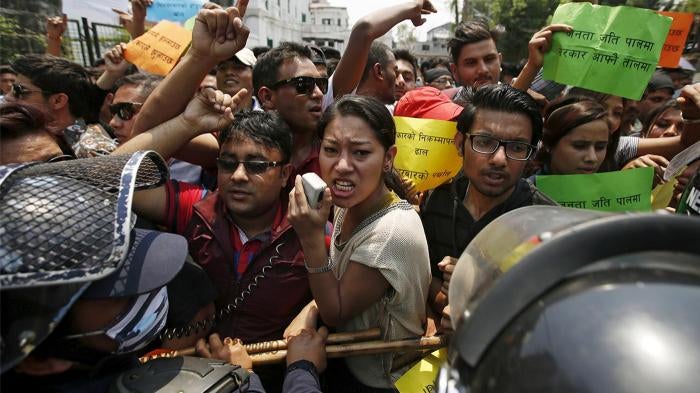Political instability persisted through 2016, with yet another change in government. A new political coalition, led by Maoist Prime Minister Pushpa Kumar Dahal, took over in July, offering some hope for a breakthrough in the political stalemate. It was the ninth government to be formed over the last eight years, damaging efforts to implement human rights protections.
A new constitution was adopted in September 2015 but violent protests over the failure to address demands for greater inclusion by minority communities, particularly in the southern plains, stalled efforts to enforce rights or provide justice for wartime abuses.
There was little progress on relief for the victims of the devastating earthquakes in 2015, which left an estimated 9,000 people dead, nearly 20,000 injured, and over 100,000 displaced.
Two transitional justice commissions set up to deliver justice to victims of the country’s 1996-2006 civil war received a reported 59,000 submissions, but the terms of reference of their future work remained unclear.
Government efforts to halt the country’s high rate of child marriage inched forward, but were stalled by lack of political will and buy-in across government ministries.
Failures in Earthquake Relief and Reconstruction
The earthquakes in 2015 left some 2.8 million people remain in need of humanitarian assistance in 14 of Nepal’s most severely affected districts. Many affected communities live in rural areas that are difficult to access, and received minimal assistance for emergency housing and other relief.
Although the government received over US$4 billion in aid for earthquake assistance, none of the funds had been paid out as late as August 2016. Political infighting led to delays in setting up an earthquake reconstruction authority; even though the body has been announced, parliament failed to legitimize it over ongoing political stalemates. As a result, earthquake victims spent two monsoons and one winter surviving in makeshift shelters they managed to put together on their own, or with the help of local initiatives.
The new government announced an increase in rehabilitation funds for earthquake victims, but as of October 2016, there was little information as to how and when the money would be disbursed.
Accountability and Justice
A hastily drafted constitution, promulgated after only one week of public consultations, led to months of violent protests, particularly along Nepal’s southern border with India. In some districts, the government responded by deploying the army and in others by instituting curfews. Although some deaths were blamed on excessive use of force by security forces, at time of writing the state had yet to investigate, let alone prosecute, those responsible for killing civilians, some of whom were children.
A tense political stalemate between rival political parties was largely responsible for this failure to provide redress. The then-ruling coalition, led by former Prime Minister Khadja Prasad Oli, was deeply reluctant to accept responsibility for the violence and humanitarian crisis arising from the new constitution. Following the transition to a new government in July 2016, the government announced the formation of an independent commission of inquiry to investigate and report on protest-related violence. As of October, the terms of reference and the commission’s composition and mandate had not yet been made public.
Women’s and Girls’ Rights
Although child marriage has been illegal in Nepal since 1963, 37 percent of girls are married by age 18, and 10 percent married before age 15. Recent research by Human Rights Watch found that police rarely act to prevent a child marriage or bring charges, and almost never do so unless a complaint is filed. Government officials often officially register child marriages.
Human Rights Watch found that poverty, lack of access to education, child labor, social pressures, and dowry practices are among the factors driving child marriage. The government has pledged to end child marriage by 2030, and in 2016 adopted a broad strategy on ending child marriage. Still missing, however, is a practical plan, and a promised process to develop one has been slow and undermined by lack of coordination and political will.
Migrant Workers
More than 2 million Nepalis work abroad, although the numbers are believed to be higher as many workers migrate through irregular channels including the porous border of India. In 2015, Nepal introduced a “free visa, free ticket” policy, whereby the employer in Gulf countries or Malaysia bears the costs of visas and flights tickets for the Nepali worker.
The Nepal Association of Foreign Employment Agencies (NEFEA) has pushed back, insisting it should be able to charge higher fees. Some workers reported to migrant rights organizations that agencies continue to charge high fees but show a receipt of the government-approved maximum fee rates.
Nepal lifted its ban on women traveling to the Gulf states for employment as domestic workers. Though motivated by protection concerns, the ban was discriminatory and forced women desperate for work to migrate through irregular channels, putting them at greater risk of exploitation. Nepal issued new guidelines allowing women over the age of 24 to migrate for domestic work in Gulf states and Malaysia with approved recruitment agencies.
The guidelines require that every domestic worker is entitled to accommodation, health and life insurance, a weekly rest day, 30 days of annual leave, regular contact with their families, and a minimum salary of $300. Such measures are important but limited as host Gulf governments continue to retain the kafala (visa sponsorship) system, which can trap domestic workers in abusive conditions as they cannot change jobs without their employer’s consent, and are punished with imprisonment and deportation if they flee.
Statelessness
The new constitution failed to address the rights of Nepal’s estimated 4 million people who are without any official status and at risk of statelessness. Despite promises of reform, many people, particularly women, children born out of wedlock, or children of a refugee or naturalized parent, remain unable to secure drivers’ licenses, passports, bank accounts, voting rights, higher education, and other government welfare schemes.
Transitional Justice
Nepal made little concrete progress on justice for serious abuses committed by both sides during its civil war that ended in 2006. At least 13,000 people were killed and over 1,300 were forcibly disappeared during the decade-long conflict. Efforts to ensure prosecutions in civilian courts for serious human rights and humanitarian law violations during the conflict remain stalled.
While Nepal has delivered interim monetary and in-kind compensation to the families of those who were “disappeared” or killed during the conflict, others, such as survivors of sexual violence or torture, have received no compensation from the state.
Despite victims groups and civil society protests against the lack of transparency and consultation in the appointment of commissioners to the Truth and Reconciliation Commission and the Disappearances Commission, the two commissions started public hearings; as of August 2016, they had received nearly 59,000 complaints.
Contrary to Supreme Court orders, the previous government had directed authorities to withdraw all wartime cases and to provide amnesty to alleged perpetrators. The new government has pledged to amend the laws and ensure justice for conflict-era victims but had yet to come up with a concrete roadmap at time of writing.
Tibetan Rights
In late February, a Chinese security delegation urged Nepali counterparts to remain on high alert during March, when Tibetans mark a number of key political anniversaries. In March, Nepali authorities attempted to prevent Tibetans from participating in elections for the Tibetan government in exile. Despite previous negotiations between the Tibetan community and Nepali authorities, Nepali police in July attempted to stop celebrations of the Dalai Lama’s birthday in Boudhanath, briefly detaining 30 people.
Sexual Orientation and Gender Identity
In line with a 2007 Supreme Court decision and a subsequent court order, the government in 2015 began issuing passports in three genders: “male,” “female,” and “other.” Some with “other” passports have successfully traveled abroad with their travel documents recognized by foreign governments. The new constitution recognizes that citizenship is available in three genders, and protects “gender and sexual minorities” in clauses related to equality before the law and social justice. Activists remain frustrated with the lack of implementation of a Supreme Court-mandated committee recommendation that the government recognize same-sex relationships.
Key International Actors
Relations with India became tense over the failure of the new constitution to address the demands of the southern Terai communities, which have close kinship ties to India. The Nepal government insisted that India was responsible for instigating protests and blocking supplies. Relations between the two countries improved after a new government led by Prime Minister Pushpa Kamal Dahal took charge, but India has failed to press for effective transitional justice for victims of the civil war.
The international community remained largely silent on the failure of the Nepali government to disburse the billions of dollars in aid received to help the earthquake affected community. The United Nations has been critical over delays in the transitional justice process.
The international community similarly remained silent on the contentious constitution drafting process, as well as on the transitional justice mechanisms.







